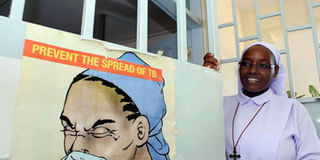Let's have first TB-free generation across Africa

A nun at a clinic in Mombasa. PHOTO | JOSEPH KANYI | NATION MEDIA GROUP
What you need to know:
Even in the midst of bleak pictures, hope can grow.
Perhaps it can start with the simple victory of child-friendly TB treatment.
If we can tackle this endemic disease of poverty and make sure children get treated, we can take this momentum and do much more.
Kenya is a high-burden tuberculosis country. In 2015, it had more than 81,000 people suffering from TB, some of whom were also infected with HIV. The number of people who die from TB has risen steadily since 2010, reaching almost 5,000 in 2015. There is also a growing number of drug-resistant TB cases.
At least one million children become ill with TB every year around the world, with 140,000 dying. Nearly 7,000 infants and children here in Kenya had TB in 2015. Those under the age of five are at a greater risk of having severe forms of TB and dying from the disease.
Caregivers infected with TB have few options but to keep caring for children, therefore many children contract TB from them. TB in children can present like other childhood conditions such as pneumonia and malnutrition. This can lead to under-diagnosis, thereby undermining the true impact of the disease in children.
Children, you see, have faster metabolism than adults and require higher doses of the TB medicines. But until now, no manufacturer had stepped forward with a product that matched the WHO dosing recommendations. As a result, parents, grandparents, and other caregivers have had to split or crush a number of unpleasant-tasting pills to approximate the dosages for children.
However, starting this month, Kenya will be the first country in the world to nationally distribute improved, pleasantly-flavoured TB medicines for children. That means that children will now have the right TB treatment in the right doses.
MORE WORK
In Kenya, we have much more work to do in combating TB. Rolling out the improved paediatric TB medicines is the first of several initiatives focusing on populations most at risk for TB. Integrating TB screening into maternal and neonatal childhood services will help identify all children with TB. New diagnostic technologies will make it much easier for health care workers to detect TB in children.
Everyone working in health care should join these efforts and ensure that no child dies of TB. Now that we have the appropriate tools, we need to increase detection efforts so that we can find children with TB who are hiding in plain sight and improve their treatment and survival. It is time for all of us to take the steps needed, accelerate this progress, and vanquish this ancient epidemic. This has to start with our children; they should be our first TB-free generation across the continent.
Even in the midst of bleak pictures, hope can grow. Perhaps it can start with the simple victory of child-friendly TB treatment. If we can tackle this endemic disease of poverty and make sure children get treated, we can take this momentum and do much more.
The future holds so much promise – and much of it could even be fruit-flavoured.
Jackson Kioko is the director of medical services at the Ministry of Health.




